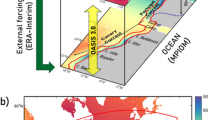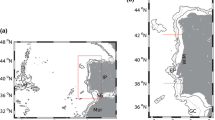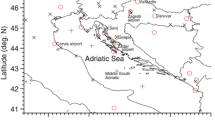Abstract
The Peruvian upwelling system (PUS) is the most productive Eastern Boundary Upwelling System (EBUS) of the world ocean. Contrarily to higher latitude EBUSs, there is no consensus yet on the response of upwelling-favorable winds to regional climate change in this region. Global climate models are not able to reproduce the nearshore surface winds, and only a few downscaling studies have been performed by using relatively coarse-grid atmospheric models forced by idealized climate change scenarios. In the present study, the impact of climate change on the PUS upwelling-favorable winds was assessed using a high resolution regional atmospheric model to dynamically downscale the multi-model mean projection of an ensemble of 31 CMIP5 global models under the RCP8.5 worst-case climate scenario. We performed a 10-year retrospective simulation (1994–2003) forced by NCEP2 reanalysis data and a 10-year climate change simulation forced by a climate change forcing (i.e. differences between monthly-mean climatologies for 2080–2100 and 1989–2009) from CMIP5 ensemble added to NCEP2 data. We found that changes in the mean upwelling-favorable winds are weak (less than 0.2 m s−1). Seasonally, summer winds weakly decrease (by 0–5%) whereas winter winds weakly increase (by 0–10%), thus slightly reinforcing the seasonal cycle. A momentum balance shows that the wind changes are mainly driven by the alongshore pressure gradient, except in a local area north of the Paracas peninsula, downstream the main upwelling center, where wind increase in winter is driven by the shoreward advection of offshore momentum. Sensitivity experiments show that the north–south sea surface temperature gradient plays an important role in the wind response along the north and central coasts, superimposed onto the South Pacific Anticyclone large-scale forcing. A reduction (increase) of the gradient induces a wind weakening (strengthening) up to 15% (25%) off the northern coast during summer. This local mechanism is not well represented in global climate models projections, which underlines the strong need for dynamical downscaling of coastal wind in order to study the impact of climate change on the Peruvian upwelling ecosystem.













Similar content being viewed by others
References
Aguirre-Velarde A, Thouzeau A, Jean F, Mendo J, Cueto-Vega R, Kawazo-Delgado M, Vásquez-Spencer J, Herrera-Sanchez D, Vega-Espinoza A, Flye-Sainte-Marie J (2019) Chronic and severe hypoxic conditions in Paracas Bay, Pisco, Peru: consequences on scallop growth, reproduction, and survival. Aquaculture 512:734259
Bakun A (1990) Global climate change and intensification of coastal ocean upwelling. Science 247(4939):198–201
Bakun A, Field D, Renondo-Rodriguez A, Weeks SJ (2010) Greenhouse gas, upwelling favourable winds, and the future of upwelling systems. Glob Change Biol 16:1213–1228
Belmadani A, Echevin V, Codron F, Takahashi K, Junquas C (2014) What dynamics drive future wind scenarios for coastal upwelling off Peru and Chile? Clim Dyn 43:1893–1914. https://doi.org/10.1007/s00382-013-2015-2
Cai W, Borlace S, Lengaigne M, van Rensch P, Collins M, Vecchi G, Timmermann A, Santoso A, McPhaden MJ, Wu L, England MH, Wang G, Guilyardi E, Jin FF (2014) Increasing frequency of extreme El Niño events due to greenhouse warming. Nat Clim Change 4:111–116. https://doi.org/10.1038/nclimate2100
Capet XJ, Marchesiello P, McWilliams JC (2004) Upwelling response to coastal wind profiles. Geophys Res Lett 31:L13311. https://doi.org/10.1029/2004GL020123
CERSAT (2002) Mean wind fields (MWF product) user manual volume 1: QuikSCAT. Rep C2-MUT-W-04-IF. CERSAT-IFR- EMER, Brest
Chamorro A, Echevin V, Colas F, Oerder V, Tam J, Quispe-Ccalluari, (2018) Mechanisms of the intensification of the upwelling-favorable winds during El Niño 1997–1998 in the Peruvian Upwelling System. Clim Dyn 51:3717–3733. https://doi.org/10.1007/s00382-018-4106-6
Chavez FP, Bertrand A, Guevara-Carrasco R, Soler P, Csirke P (2008) The northern Humboldt current system: brief history, present status and a view towards the future. Prog Oceanogr 79(2–4):95–105. https://doi.org/10.1016/j.pocean.2008.10.012
Chelton DB, Esbensen SK, Schlax MG, Thum N, Freilich MH, Wentz FJ, Gentemann CL, McPhaden MJ, Schopf PS (2001) Observations of coupling between surface wind stress and sea surface temperature in the Eastern Tropical Pacific. J Clim 14:1479–1498. https://doi.org/10.1175/1520-0442(2001)014%3c1479:OOCBSW%3e2.0.CO;2
Chen F, Dudhia J (2001) Coupling an advanced land surface hydrology model with the Penn state-NCAR MM5 modeling system. Part II: Preliminary model validation. Mon Weather Rev 129(4):587–604. https://doi.org/10.1175/1520-0493(2001)129%3c0587:CAALSH%3e2.0.CO;2
Cushing D (1990) Plankton production and year class strength in fish populations: an update of the match/mismatch hypothesis. Adv Mar Biol 26:250–294
Dudhia J (1989) Numerical study of convection observed during the winter monsoon experiment using a mesoscale two-dimensional model. J Atmos Sci 46:3077–3107. https://doi.org/10.1175/1520-0469(1989)046%3c3077:NSOCOD%3e2.0.CO;2
Dutheil C, Bador M, Lengaigne M, Lefevre J, Jourdain N, Vialard J, Jullien S, Peltier A, Menkes C (2019) Impact of surface temperature biases on climate change projections of the South Pacific Convergence Zone. Clym Dym 53:3197–3219. https://doi.org/10.1007/s00382-019-04692-6
Echevin V, Aumont O, Ledesma J, Flores G (2008) The seasonal cycle of surface chlorophyll in the Peruvian upwelling system: a modelling study. Prog Oceanogr 79:167–176
Echevin V, Colas F, Espinoza-Morriberon D, Vasquez L, Anculle T, Gutierrez D (2018) Forcings and evolution of the 2017 coastal El Niño Off Northern Peru and Ecuador. Front Mar Sci 5:367. https://doi.org/10.3389/fmars.2018.00367
Echevin V, Gévaudan M, Espinoza-Morriberón D, Tam J, Aumont O, Gutierrez D, Colas F (2020) Physical and biogeochemical impacts of RCP8.5 scenario in the Peru upwelling system. Biogeosciences 17:3317–3341. https://doi.org/10.5194/bg-17-3317-2020
Garreaud RD (2018) A plausible atmospheric trigger for the 2017 coastal El Niño. Int J Climatol 38:e1296–e1302. https://doi.org/10.1002/joc.5426
Goubanova K, Echevin V, Dewitte B, Codron F, Takahashi K, Terray P, Vrac M (2011) Statistical downscaling of sea–surface wind over the Peru–Chile upwelling region: diagnosing the impact of climate change from the IPSL-CM4 model. Clim Dyn 36(7):1365–1378
Gutiérrez D, Bouloubassi I, Sifeddine A, Purca S, Goubanova K, Graco M, Field D, Méjanelle L, Velazco F, Lorre A, Salvatteci R, Quispe D, Vargas G, Dewitte B, Ortlieb L (2011) Coastal cooling and increased productivity in the main upwelling zone off Peru since the mid-twentieth century. Geophys Res Lett 38:L07603. https://doi.org/10.1029/2010GL046324
Hong S, Lim J (2006) The WRF single-moment 6-class microphysics scheme (WSM6). J Korean Meteorol Soc 42(2):129–151
Janjic ZI (1994) The step-mountain eta coordinate model: further developments of the convection, viscous sublayer, and turbulence closure schemes. Mon Weather Rev 122:927–945. https://doi.org/10.1175/1520-0493(1994)122%3c0927:TSMECM%3e2.0.CO;2
Jebri B, Khodri M, Echevin V, Gastineau G, Thiria S, Vialard J, Lebas N (2020) Contributions of internal variability and external forcing to the recent trends in the Southeastern Pacific and Peru–Chile upwelling system. J Clim. https://doi.org/10.1175/JCLI-D-19-0304.1
Kanamitsu M, Ebisuzaki W, Woollen J, Yang S-K, Hnilo JJ, Fiorino M, Potter GL (2002) NCEP–DOE AMIP-II reanalysis (R-2). Bull Am Meteorol Soc 83(11):1631–1644
Kawase H, Yoshikane T, Hara M, Ailikun B, Kimura F, Yasunari T (2008) Downscaling of the climatic change in the Mei-yu rainband in East Asia by a pseudo climate simulation method. SOLA 4:73–76. https://doi.org/10.2151/sola.2008-019
Kawase H, Yoshikane T, Hara M, Kimura F, Yasunari T, Ailikun B, Ueda H, Inoue T (2009) Intermodel variability of future changes in the Baiu rainband estimated by the pseudo global warming downscaling method. J Geophys Res 114:D24110. https://doi.org/10.1029/2009JD011803
Marti O, Braconnot P, Dufrense JL et al (2010) Key features of the IPSL ocean atmosphere model and its sensitivity to atmospheric resolution. Clim Dyn 34:1–26
Mechoso CR, Wood R, Weller R, Bretherton CS, Clarke AD, Coe H, Fairall C, Farrar T, Feingold G, Garreaud R, Grados C, McWilliams J, De Szoeke SP, Yuter SE, Zuidema P (2014) Ocean–cloud–atmosphere–land interactions in the southeastern pacific. Bull Am Meteorol Soc 95(3):357–375
Mlawer E, Taubman S, Brown P, Iacono M, Clough S (1997) Radiative transfer for inhomogeneous atmosphere: RRTM, a validated correlated-k model for the long-wave. J Geophys Res 102:16663–16682. https://doi.org/10.1029/97JD00237
Nakanishi M, Niino H (2009) Development of an improved turbulence closure model for the atmospheric boundary layer. J Meteorol Soc Jpn 87:895–912. https://doi.org/10.2151/jmsj.87.895
Narayan N, Paul A, Mulitza S, Schulz M (2010) Trends in coastal upwelling intensity during the late 20th century. Ocean Sci 6(3):815–823
Oerder V, Colas F, Echevin V, Codron F, Tam J, Belmadani A (2015) Peru–Chile upwelling dynamics under climate change. J Geophys Res 120(2):1152–1172. https://doi.org/10.1002/2014JC010299
Oerder V, Colas F, Echevin V, Masson S, Hourdin C, Jullien S, Gurvan M, Lemarié F (2016) Mesoscale SST-wind stress coupling in the Peru–Chile current system: which mechanisms drive its seasonal variability? Clim Dyn 47:2309. https://doi.org/10.1007/s00382-015-2965-7
Oerder V, Colas F, Echevin V, Masson S, Lemarié F (2018) Impacts of the mesoscale ocean–atmosphere coupling on the Peru–Chile ocean dynamics: the current-induced wind stress modulation. J Geophys Res Oceans 123:812–833. https://doi.org/10.1002/2017JC013294
Oyarzún D, Brierley CM (2019) The future of coastal upwelling in the Humboldt current from model projections. Clim Dyn 52:599–615
Perlin N, Skyllingstad E, Samelson R (2011) Coastal atmospheric circulation around an idealized cape during wind-driven upwelling studied from a coupled ocean–atmosphere model. Mon Weather Rev 139:809–829
Reynolds RW, Smith TM, Liu C, Chelton DB, Casey KS, Schlax MG (2007) Daily high-resolution-blended analyses for sea surface temperature. J Clim 20:5473–5496. https://doi.org/10.1175/2007JCLI1824.1
Rykaczewski RR, Dunne JP, Sydeman WJ, García-Reyes M, Black BA, Bograd SJ (2015) Poleward displacement of coastal upwelling-favorable winds in the ocean’s eastern boundary currents through the 21st century. Geophys Res Lett 42:6424–6431
Skamarock W, Klemp J (2008) A time-split nonhydrostatic atmospheric model for weather research and forecasting applications. J Comp Phys 227:3465–3485. https://doi.org/10.1016/j.jcp.2007.01.037
Small RJ et al (2008) Air–sea interaction over ocean fronts and eddies. Dyn Atmos Oceans 45:274–319. https://doi.org/10.1016/j.dynatmoce.2008.01.001
Soares PMM, Lima DCA, Semedo A, Cardoso RM, Cabos W, Sein D (2018) The North African coastal low level wind jet: a high resolution view. Clim Dyn 53:1211–1230. https://doi.org/10.1007/s00382-018-4441-7
Sydeman WJ, García-Reyes M, Schoeman DS, Rykaczewski RR, Thompson SA, Black BA, Bograd SJ (2014) Climate change and wind intensification in coastal upwelling ecosystems. Science 345(6192):77–80
Takahashi K, Martínez AG (2017) The very strong coastal El Niño in 1925 in the far-eastern Pacific. Clim Dyn 52:7389–7415. https://doi.org/10.1007/s00382-017-3702-1
van Vuuren DP, Edmonds J, Kainuma M, Riahi K, Thomson A, Hibbard K, Hurtt GC, Kram T, Krey V, Lamarque JF, Masui T, Meinshausen M, Nakicenovic N, Smith SJ, Rose SK (2011) The representative concentration pathways: an overview. Clim Change 109(1):5–31
Wang D, Gouhier TC, Menge BA, Ganguly AR (2015) Intensification and spatial homogenization of coastal upwelling under climate change. Nature 518(7539):390–394
Worley SJ, Woodruff SD, Reynolds RW, Lubker SJ, Lott N (2005) ICOADS release 2.1 data and products. Inter J Climatol 25(7):823–842. https://doi.org/10.1002/joc.1166
Yeh S, Kug J, Dewitte B, Kwon M-H, Kirtman BP, Jin F-F (2009) El Niño in a changing climate. Nature 461:511–514. https://doi.org/10.1038/nature08316
Acknowledgements
This research is a product of the scientific cooperation between the Peruvian Marine Research Institute (IMARPE) and the Institut de Recherche pour le Developpement (IRD—France) in the framework of the IRD LMI DISCOH program. Numerical simulations were performed on TGCC Curie and Irene SKL High Performance Computers under projects A0050101140 and A0060101140. Nicolas Jourdain is acknowledged for processing the ensemble-mean lateral boundary conditions for the regional atmospheric model simulations. Francis Codron, Jose Rutllant, Pierrick Penven, Claude Estournel and Sebastien Masson are acknowledged for fruitful discussions. J. Tam, D. Gutierrez and A. Chamorro acknowledge finantial support from the Adaptation Fund project “Adaptation to the Impacts of Climate Change on Peru’s Coastal Marine Ecosystem and Fisheries”. J. Tam, F. Colas and A. Chamorro acknowledge financial support from the project Concytec—World Bank, through Fund for Scientific, Technological, and Technological Innovation Development (Fondecyt), for the project “Characterization and forecast of extreme events in the Peruvian ocean using an operational system of oceanic information”.
Author information
Authors and Affiliations
Corresponding author
Additional information
Publisher's Note
Springer Nature remains neutral with regard to jurisdictional claims in published maps and institutional affiliations.
Rights and permissions
About this article
Cite this article
Chamorro, A., Echevin, V., Dutheil, C. et al. Projection of upwelling-favorable winds in the Peruvian upwelling system under the RCP8.5 scenario using a high-resolution regional model. Clim Dyn 57, 1–16 (2021). https://doi.org/10.1007/s00382-021-05689-w
Received:
Accepted:
Published:
Issue Date:
DOI: https://doi.org/10.1007/s00382-021-05689-w




